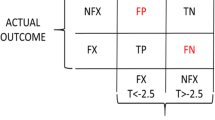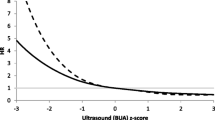Abstract
Normative population data are reported here for velocity of ultrasound in tibial cortical bone in a population-based sample of both men and women (n=371). The cortical measurement is highly precise with reproducibility of the order of 0.5%. As with heel and patellar trabecular velocity, tibial cortical velocity declines with age from the fourth through the ninth decades. The rate is 1.7 m/s per year in men and 4.1 m/s per year in women. Tibial cortical velocity values correlate with patellar velocity and with forearm mineral, with correlation coefficients ranging from + 0.46 to +0.54 in women and +0.27 to +0.43 in men (P<0.002 for all). Tibial velocity averaged 77–104 m/s lower (2–3%: equal to about 1 SD of the young adult normal distribution) in individuals with a history of low-energy appendicular fractures (P<0.05), and the difference remained significant after adjusting for age. However, there were no perceptible differences in tibial velocity for those with and without vertebral fractures. Odds ratios derived from logistic regression showed an approximate twofold increase in likelihood of low-energy appendicular fracture for every standard deviation decrement in velocity. Comparison of tibial velocity with patellar velocity and forearm density in the same individuals revealed tibial velocity to be more strongly associated with appendicular fractures than patellar velocity for women and about the same for men, and less strongly associated than patellar velocity for vertebral fractures. We conclude that tibial cortical velocity provides useful information about bone status in populations at risk for osteoporosis, and seems particularly well suited for assessing appendicular fracture risk.
Similar content being viewed by others
References
Baran DT, Kelly AM, Karellas A, et al. Ultrasound attenuation of the os calcis in women with osteoporosis and hip fractures. Calcif Tissue Int 1988;43:138–42.
Baran DT, McCarthy CK, Leahey D, Lew R. Broadband ultrasound attenuation of the calcaneus predicts lumbar and femoral neck density in Caucasian women: a preliminary study. Osteoporosis Int 1991;1:110–3.
Porter RW, Johnson K, McCutchan JDS. Wrist fracture, heel bone density and thoracic kyphosis: a case control study. Bone 1990;11:211–4.
Agren M, Karellas A, Leahey D, Marks S, Baran D. Ultrasound attenuation of the calcaneus: a sensitive and specific discriminator of osteopenia in postmenopausal women. Calcif Tissue Int 1991;48:240–4.
Rossman P, Zagzebski J, Mesina C, Sorenson J, Mazess R. Comparison of speed of sound and ultrasound attenuation in the os calcis to bone density of the radius, femur and lumbar spine. Clin Phys Physiol Meas 1989;10:353–60.
Greenfield MA, Craven JD, Huddleston A, Kehrer ML, Wishko D, Stern R. Measurement of the velocity of ultrasound in human cortical bone (in vivo). Radiology 1981;138:701–10.
Heaney RP, Avioli LV, Chesnut C III, Brandenburger GH, Lappe J, Recker RR. Osteoporotic bone fragility: detection by ultrasound transmission velocity. JAMA 1989;261:2986–90.
Zagzebski JA, Rossman PJ, Mesina C, Mazess RB, Madsen EL. Ultrasound transmission measurements through the os calcis. Calcif Tissue Int 1991;49:107–11.
Seeley DG, Browner WS, Nevitt MC, Genant HK, Scott JC, Cummings SR. Which fractures are associated with low appendicular bone mass in elderly women? Ann Int Med 1991;115:837–42.
Stegman MR, Heaney RP, Recker RR, Travers-Gustafson D, Leist J. Velocity of ultrasound and its association with fracture history in a rural population. Am J Epidemiol 1994;139:1027–34.
Davies KM, Recker RR, Heaney RP. Revisable criteria for vertebral deformity. Osteoporosis Int 1993;3:265–70.
Stegman MR, Travers-Gustafson D, Leist J, Heaney RP, Recker RR. Comparison of bone quality of volunteers to randomly sampled study participants. J Bone Miner Res 1993;8:S 336.
Orgee J, McCloskey EV, Foster H, Coombes G, Khan S, Kanis JA. Tibial ultrasound velocity: a useful clinical measure of skeletal status. J Bone Miner Res 1994;9:S156.
Author information
Authors and Affiliations
Rights and permissions
About this article
Cite this article
Stegman, M.R., Heaney, R.P., Travers-Gustafson, D. et al. Cortical ultrasound velocity as an indicator of bone status. Osteoporosis Int 5, 349–353 (1995). https://doi.org/10.1007/BF01622257
Received:
Accepted:
Issue Date:
DOI: https://doi.org/10.1007/BF01622257




